Endgame Pre-Game: A Novice Avengers Guide to the Movie of the Year
Let’s say you’re a hardcore Marvel fan. You’ve seen every film in the Marvel Cinematic Universe. You’ve waited by your device for the split-second those advance tickets went on sale. You’re wearing your Avengers T-shirt, you’ve pre-ordered your Marvel Legends figures, and you’ve watched the previous 21 films one more time to get prepared for Avengers: Endgame.
This article isn’t for you.
Don’t get us wrong. You can still read and enjoy it, but this piece is for the Casual Observer. The parent or grandparent that isn’t steeped in Marvel lore, the person that has trouble separating Ant-Man from Spider-Man or wonders why there’s a talking raccoon with a gun. Maybe you’ve heard that this Avengers: Endgame movie is a big deal, breaking box-office records before it even opens, or maybe you just want to go with your more versed family and friends for some blockbuster fun. Whatever the case, you might like a quick guide to the end of this phase of the MCU. And we’re here to help.
Note: Includes spoilers to earlier Marvel movies.
1. What’s Happening?
Avengers: Endgame is the 22nd film in the Marvel Cinematic Universe (MCU), and it’s directed by Anthony and Joe Russo. Starting with Iron Man in 2008, the various Marvel Studios movies have common threads that eventually wove all of the major players together for last year’s Avengers: Infinity War. The main plot concerns intergalactic villain Thanos (Josh Brolin) gathering the six ancient and powerful Infinity Stones; though the combined forces of the Avengers and the Guardians of the Galaxy tried to stop him, they failed. Thanos combined the six stones into his Infinity Gauntlet, which he used to wipe out half of all life in the universe in his own twisted vision of bringing balance to existence. In Avengers: Endgame, our surviving heroes (with some help from new arrival Captain Marvel) will take one last desperate gamble to make things right.
2. Who Survived?
We’ll answer that question and its flipside, which is “Who got dusted?”
The survivors are:
- Captain America (Chris Evans)
- Iron Man (Robert Downey Jr.)
- Thor (Chris Hemsworth)
- Black Widow (Scarlett Johansson)
- Hawkeye (Jeremy Renner)
- Bruce Banner/Hulk (Mark Ruffalo)
- Okoye (Danai Gurira)
- War Machine (Don Cheadle)
- Ant-Man (Paul Rudd)
- Captain Marvel (Brie Larson)
- Nebula (Karen Gillan)
- Wong (Benedict Wong)
- M’Baku (Winston Duke)
- Pepper Potts (Gwyneth Paltrow)
- Rocket Raccoon (voice of Bradley Cooper)
Among the heroes that disintegrated when Thanos snapped were:
- Winter Soldier (Sebastian Stan)
- Falcon (Anthony Mackie)
- Black Panther (Chadwick Boseman)
- Scarlet Witch (Elizabeth Olsen)
- Star-Lord (Chris Pratt)
- Drax (Dave Bautista)
- Mantis (Pom Klementieff)
- Groot (voice of Vin Diesel)
- Doctor Strange (Benedict Cumberbatch)
- Nick Fury (Samuel L. Jackson)
- Maria Hill (Cobie Smulders)
- Shuri (Letitia Wright)
- Hank Pym (Michael Douglas)
- Janet Van Dyne (Michelle Pfeiffer)
- Wasp (Evangeline Lilly)
- Spider-Man (Tom Holland)
Gamora (Zoe Saldana), Vision (Paul Bettany), Heimdall (Idris Elba), and Loki (Tom Hiddleston) all fell to Thanos prior to his use of the Infinity Gauntlet. So yes, the odds are stacked against the good guys.
3. Hey, Some of Those People Weren’t in the Last Movie, Were They?
Good eye, Hypothetical Question Asker. Hawkeye was completely absent from Infinity War, having retired after the events of Captain America: Civil War to spend time with his family. But trailers and merchandising have indicated that not only does Clint Barton return, he does so in his Ronin persona, a costumed identity that comes from the comics and has served as a rotating incognito mantle for heroes in need of hiding, like Hawkeye, Echo, and Blade. Ant-Man was trapped in the Quantum Realm at the end of Ant-Man and The Wasp, which also showed several members of his supporting cast falling victim to Thanos’s snap. In Nick Fury’s final moments, he activated a pager; if you saw Captain Marvel, you know the significance of that moment and know from that film’s post-credits scene that the good Captain hauled it back to Earth to answer her old friend’s call.
4. Do I Have to Have Seen All 21 Previous Movies to Understand This One?
No. And yes. Think of it like this: you’re essentially tuning into the equivalent of a season finale. The Marvel Studios films have told an interconnected story (with some chapters more essential than others) that introduced the heroes, slowly rolled in the Infinity Stones and the threat of Thanos, and established important character relationships and locations, all of which came to a head in Infinity War. You can probably get by with seeing Infinity War and still be okay. If you wanted to knock out a quick marathon of the most essential chapters, watch, in order of release, Avengers, Captain America: The Winter Soldier, Guardians of the Galaxy, Avengers: Age of Ultron, Ant-Man, Captain America: Civil War, Black Panther, and Avengers: Infinity War.
Alternatively, you could watch Jimmy Fallon’s rundown of the MCU set to a parody of Bill Joel’s “We Didn’t Start the Fire” as performed by the cast. That might do it.
Jimmy Fallon and the Avengers recap the MCU to “We Didn’t Start the Fire.” (Uploaded to YouTube by The Tonight Show Starring Jimmy Fallon)
5. Why Do People Keep Acting Like It’s the End If There Are More Marvel Movies Coming?
Avengers: Endgame is the next-to-last film of the so-called Phase 3; Marvel has grouped their films into loosely connected “phases” since 2008’s Iron Man. Marvel Studios President Kevin Feige has indicated that July’s Spider-Man: Far from Home is the official end of this Phase, and that the next film will initiate Phase 4. Endgame, however, does mark the end of the story of the Infinity Stones and the original six-member line-up of the Avengers team. A number of actors may be departing the franchise after this chapter, so it’s seen in many ways as a conclusion and passing of the torch, even as we wait on upcoming films like The Eternals and Shang-Chi.
6. Do They Still Make Marvel Comics?
YES. Comic books are a vibrant, thriving medium, and Marvel is in the thick of it. You can find your nearest local comic shop using the Comic Shop Locator. Moreover, the annual Free Comic Book Day is on May 4; that’s when comic shops and other locations that stock graphic novels (like Barnes & Noble and your local libraries) offer free comics from a variety of companies for audiences of all ages.
If you’re curious as to where the actual story of the films started, the Marvel Universe as we know it is grounded in the work of hundreds of creators, but most notably the late Stan Lee and Jack Kirby. Writer-artist Jim Starlin created Thanos in 1973; the villain’s obsession with the Infinity Gems (same thing) originated during a run of appearances in Silver Surfer in 1990, and led to a two-issue Thanos Quest special that saw him working to acquire them. The following year’s Infinity Gauntlet mini-series provides a very large amount of the inspiration behind Infinity War and Endgame. You can get some more in-depth Marvel history at the character sections of their own site.
7. Is There Anything Else I Absolutely Need to Know?
It’s three hours long with no intermission, so make a pit-stop ahead of time. Also, according to advance, non-spoilery reviews, it’s allegedly an action masterpiece, an emotional rollercoaster, and unexpectedly funny (even for Marvel). No less an authority than legendary comics writer Mark Waid (whom himself has written Avengers, Captain America, and Spider-Man comics and has seen his own work make it into animation, television, and film), wrote on his Facebook page that, “I have not experienced such unbridled joy at a super-hero movie since I first saw Christopher Reeve.”
Hopefully you’ve picked up enough info to allow you to slide comfortably into what’s likely the biggest film event of the year. Remember to arrive early, dress comfortably, and join the millions that have already gotten their tickets to assemble. As a wise man once said, “Excelsior!”
Featured image: Shutterstock
Higher, Further, Faster: 5 Things You Need to Know about Captain Marvel
The first female-led film from Marvel Studios, Captain Marvel, starring Brie Larson, opens in wide release just in time for International Women’s Day. It’s an appropriate date, given both the tone and history of the character Carol Danvers. With over 50 years of comics behind her, she’s been a journalist, a fighter pilot, an Avenger, and more. As the certain box office hit opens, we look back at five things you should know about the Captain, and why she’s not the only hero to bear the name.
1. Wasn’t the Shazam! guy called Captain Marvel?
It’s a source of a lot of confusion in both fandom and mainstream circles, but yes, there have been a few Captain Marvels at different companies. The most obscure (and goofiest) was a character from M.F. Enterprises that appeared in a comic series in the mid-1960s. This Captain Marvel was an alien robot that could detach his limbs. However, the character only appeared in a handful of issues before receiving a career-ending legal smackdown during a case that involved both Marvel Comics and DC Comics.
The “Shazam!” Captain Marvel debuted in 1939 in Whiz Comics #2 from Fawcett Comics (the cover date says 1940, but it hit stores a bit earlier). Created by Bill Parker and C.C. Beck, young Billy Batson was chosen by the wizard Shazam to receive super-powers (and an adult body) when he said the wizard’s name. The utterance gave him the wisdom of Solomon, the strength of Hercules, the stamina of Atlas, the power of Zeus, the courage of Achilles, and the speed of Mercury. Billy adopted the name Captain Marvel for his adventuring. In the 1940s, sales of the character rivaled, and occasionally surpassed, those of Superman. Unfortunately for Fawcett, National (as DC was known at that time) took umbrage to the similarities between the good Captain and Superman, and sued in 1941. The legal challenges went on for years through multiple trials and iterations before Fawcett settled for $400,000 and stopped publishing Captain Marvel titles by 1954.
In 1967, Marvel decided to publish their own book called Captain Marvel, starring an alien superhero (more on him in a minute). They registered the trademark. When DC licensed the Shazam! characters from Fawcett for a revival in the 1970s, Marvel challenged them over the use of the title. Since that time, all of DC’s books featuring the character have used the Shazam title due to Marvel’s copyright. Since the 2000s, the character itself is now called Shazam in the comics, and shall be in April’s Shazam! film as well.
2. So who are the Captain Marvels of Marvel Comics?
The first Marvel Comics Captain Marvel was, wait for it, Captain Mar-Vell. Created by Stan Lee and artist Gene Colan, Mar-Vell debuted in Marvel Super-Heroes #12 in 1967. A human-looking alien from the Kree Empire, Mar-Vell is sent to Earth to spy on our planet’s developing space program. Mar-Vell eventually turns against his masters and fights to protect the planet under his new heroic identity. He would become an ally and member of the Avengers.
Originally introduced as a love interest for Mar-Vell by Colan and writer Roy Thomas, Carol Danvers first appeared in Marvel Super-Heroes #13. An Air Force officer, Danvers is handling security at a base and meets Dr. Walter Lawson (Mar-Vell’s newly adopted secret identity). A few issues later, Danvers is caught in an explosion caused by an alien device. Since this is Marvel Comics, accidents with radiation and alien devices invariably give you super-powers.
When Carol Danvers showed up again, it was to headline the new comic Ms. Marvel in 1977. As the titular hero, Danvers had gained super-strength, speed, and the power of flight. The “Ms.” served as a hat-tip to Gloria Steinem; in fact, Danvers would soon be running a magazine and demanding equal pay for her work. She too joined the Avengers and was a mainstay of that comic for several years, even after hers was cancelled in 1979 with issue #23. After some unfortunate writing and editorial decisions removed Danvers from the Avengers title, popular X-Men writer Chris Claremont (who had also written issues of Ms. Marvel) stepped in and brought Danvers to his stable of books in 1982. He gave her a power-up and the new name Binary and sent her off into space with Marvel’s space pirate characters, the Starjammers.
With Ms. Marvel in space and Mar-Vell gone (the character died of cancer in a 1982 special), the name Captain Marvel was available. Writer Roger Stern and artist John Romita Jr. created a new Captain Marvel for The Amazing Spider-Man Annual #16 in 1982. The fact that the new Captain was a black woman, New Orleans harbor patrol officer Monica Rambeau, generated a lot of positive publicity and some mild shock in some fan circles. The energy-powered Rambeau became popular quickly, joining (surprise!) the Avengers and even landing the cover of Marvel’s first role-playing game in 1984. Rambeau ran with the Captain Marvel name until 1996, when she ceded it to Mar-Vell’s son Genis and took the identity of Photon. Rambeau has since had a few different code names; today she’s called Spectrum. During this time, Carol returned to Earth, rejoined the Avengers, and used the name Warbird before becoming Ms. Marvel again.
As for Genis-Vell (created by Ron Marz and Ron Lim), he’s one of three children of Mar-Vell (dude got around). Both Genis and Mar-Vell’s daughter, Phyla, have used the Captain Marvel name over time. Genis headlined a couple of solo series, joined the Thunderbolts, and eventually allowed himself to be destroyed when his powers got out of control and threatened the universe. Phyla-Vell (created by Peter David and Paul Azaceta) would likewise run through a few code names, but her adventures have primarily been showcased alongside the team that she joined, the Guardians of the Galaxy. Mar-Vell’s third child is Teddy Altman, aka Hulkling. The son of Mar-Vell and a Skrull princess, Teddy uses his shape-shifting and strength powers as a member of the Young Avengers, usually preferring an appearance resembling a teen Hulk.
For a brief period, Kree hero Noh-Varr, known as Marvel Boy, was persuaded by villain Norman Osborn to join his so-called Dark Avengers as a new Captain Marvel. Noh-Varr used the name for only a brief time. He soon abandoned Osborn for a role with both the main Avengers team, where he went by the name Protector, and the Young Avengers.
In 2012, Carol finally took the name Captain Marvel and got a new first issue. Written by Kelly Sue DeConnick with art by Dexter Soy, this comic launched the stories that serve as the basis for the character that will be seen in the new film. Danvers maintains membership in the Avengers, but she also leads Alpha Flight, Earth’s space-based first line of defense against alien threats.
3. Speaking of alien threats, who are the Kree and the Skrulls?
The Kree Empire is a conglomeration of worlds run by the Supreme Intelligence. An amalgam of all the great Kree minds stretching back centuries, the Intelligence is seen in comics as a giant green head. In the film, it will be seen as a regular-sized Annette Bening. Kree look like humans, though a number of them have blue skin tones. They frequently represent themselves as having good intentions, but that’s not always the case. Their search for genetic purity resulted in the creation of the Inhumans characters, and other machinations have put them in conflict with the heroes of Marvel Comics many times.
The Skrulls are the sworn enemies of the Kree. Distinguished by green skin, wrinkly chins, and pointy ears, the Skrulls use their shape-shifting abilities to spy and sow chaos. First encountered by the Fantastic Four in their second issue, the Skrulls have bedeviled the Marvel Universe for years, notably during the Secret Invasion story of the 2000s, when they kidnapped and replaced a number of heroes.
The biggest Kree/Skrull story is the “Kree-Skrull War,” which took place over the course of nine issues of The Avengers between 1971 and 1972; it was written by Roy Thomas with art by Neal Adams, Sal Buscema, and John Buscema. It’s been reported that some elements of this story surface in the Captain Marvel film.
4. What makes Captain Marvel important as a character?
Carol Danvers has been breaking stereotypes about female comic book characters for over 50 years. Her military background, ever-increasing power-set, and take-charge demeanor set her apart. The character has been depicted as having to overcome obstacles like sexism, but also personal demons like alcoholism and a rough childhood. She doesn’t always make the right decisions, and her strong will occasionally places her at odds with other heroes.
Nevertheless, she fights from a place of good intentions and maintains a number of strong friendships with other female heroes like Spider-Woman (Jessica Drew) and Rambeau. Her romantic life is often a mess, but that has never been a defining characteristic. Her prominent role in the Marvel Universe is shown to have inspired other heroes. Muslim teen Kamala Khan (created by writer G. Willow Wilson, editors Sana Amanat and Stephen Wacker, and artists Adrian Alphona and Jamie McKelvie) became the new Ms. Marvel in 2014 as a tribute to Danvers.
In the films, Captain Marvel’s solo movie sets us up for the character’s entry in Avengers: Endgame in April. That film, the 22nd entry in Marvel’s Cinematic Universe, wraps up the original three “phases” of the MCU that began with Iron Man in 2008. Marvel Studios president Kevin Feige has noted more than once that Captain Marvel will be one of the central characters of the MCU as the post-Endgame slate of films proceeds.
5. That’s all great, but what about Goose the cat?
The first trailer for Captain Marvel (Uploaded to YouTube by Marvel Entertainment)
In the comics, Captain Marvel’s cat is named Chewie, after Chewbacca from the Star Wars saga. They renamed Chewie “Goose” in the film as a tribute to Tom “Maverick” Cruise’s Radio Intercept Officer sidekick played by Anthony Edwards in Top Gun. As for Goose’s overall importance . . . let’s just say she’s probably a little bit more than she initially appears to be.
Feature image: Shutterstock
Seven Reasons Why Aquaman Is No Joke
As the big-budget Aquaman film opens in the U.S. on Friday, December 21, a certain segment of the population continues to ask with disbelief, “Wait, Aquaman gets a movie?” This sentiment is based on years of jokes and pop culture punchlines associated with a character many people have dismissed as “the guy who talks to fish.” But if you take a deep dive into the history of this DC Comics mainstay, who was created in 1941 by Mort Weisinger and Paul Norris, you’ll find that he has a much more complicated background than that. Here are seven reasons why Aquaman is no joke.
1. He’s Royalty
Batman comes from crime, and Superman comes from science fiction, but Wonder Woman comes from mythology, and so does Aquaman. Like the Amazon princess, Aquaman is royalty. Known as Orin in his kingdom of Atlantis and Arthur Curry on the surface, Aquaman is the son of a human lighthouse keeper and an Atlantean princess. The combination makes him a meta-human, possessed of Atlantean abilities like aquatic telepathy (the talking-to-fish bit), enhanced strength, and remarkable swimming abilities. In Atlantis, though he is occasionally deposed through various plot twists and machinations, he’s recognized as a rightful heir to the throne and as a just king.
2. He’s Co-founded the Justice League

In The Brave and The Bold #28, Aquaman becomes one of the founding members of the Justice League of America, a new and modern take on the 1940s Justice Society. Aquaman’s teammates include Batman, Superman, Wonder Woman, The Flash (Barry Allen), Green Lantern (Hal Jordan), and the Martian Manhunter. Aquaman has been a vital part of the JLA throughout its history, and even serves as its leader for a period in the 1980s.
3. He Was the First Major Superhero to Get Married

Mera debuted in September 1963, appearing for the first time in Aquaman #11. A queen from another dimension, Mera recruits Aquaman and his sidekick, Aqualad, to win back her throne. Mera later leaves her kingdom to join Aquaman. The couple marries in Aquaman #18 (1964) as Aquaman ascends to the throne of Atlantis. In tying the knot, Aquaman became the first major superhero to wed in his own book without it being a gimmick or imaginary story (something that was particularly common in Superman books of the time).
4. He Was the First Superhero to Become a Parent (and to Lose a Child)

Aquaman and Mera waste no time starting a family. In 1965’s issue #23, Mera gives birth to Arthur Jr., making Aquaman and Mera the first major superheroes to welcome a proper legacy character who isn’t just a sidekick. Arthur Jr. (nicknamed Aquababy) preceded the first appearance of famous superhero progeny Franklin Richards (son of Marvel’s Mr. Fantastic and the Invisible Woman) by three years.
Sadly, Arthur Jr. becomes a pawn in the ongoing war between Aquaman and his nemesis, Black Manta. In Adventure Comics #452, Arthur Jr. suffocates and dies in a trap laid by Black Manta. Issue #60 of Aquaman depicts the devastating aftermath: Mera returns from a journey to her home dimension for a device that could save her son and is informed that he has already died. The gravity of the situation underscores the seriousness that settled into comic storylines during that decade, which would continue into the “grim and gritty ’80s.”
5. He’s New to Movies, but Had a Long Life in Television
Aquaman became a television fixture beginning in 1967. That’s when the character made his animated debut in The Superman/Aquaman Hour of Adventure on CBS. The show, while certainly directed at kids, is fairly faithful to the comics, and includes Mera, Aqualad, and a number of their animal companions, like Tusky the walrus. The following year, Aquaman was spun off into its own 30-minute timeslot on Saturday mornings, partially repackaging segments from the original show.
The opening sequence for every season of Super Friends.
In 1973, Aquaman was chosen as one of the five leads of Super Friends, alongside Superman, Wonder Woman, Batman, and Robin. The series proved to be a major Saturday-morning hit that ran in various iterations until 1986. Aquaman was present in every season, but it’s here that the “I’ll check the coasts” cliché surrounding his effectiveness came into being. Though he occasionally presents the solution to problems or provides critical assistance, Aquaman frequently plays in the background to the Big Three. He was well represented in merchandising of the time, receiving action figures in various lines from Mego and Kenner, and appearing on lunchboxes and, yes, Underoos.
Attacking Aquaman with water is a poor plan. From Justice League Unlimited.
After the modern DC Animated Universe kicked off in the 1990s, Aquaman shows up for the first time in an episode of Superman: The Animated Series. Unfortunately, Aquaman wasn’t a founder of the Justice League in the subsequent Justice League and Justice League Unlimited series, but he did appear a number of times as an ally. Here, the character has the long hair and beard from his ’90s comic look (we’ll get to that in a minute). Aquaman is also referenced in the future-set Batman Beyond, as his daughter is a member of the future Justice League.
Aquaman wants out of his family vacation on Batman: The Brave and The Bold.
An extremely popular take on the character appeared regularly in the more humorous Batman: The Brave and the Bold series of 2008-2011. Voiced by John DiMaggio (the comedian also known for voicing Bender on Futurama and Jake on Adventure Time), Aquaman is depicted as a swaggering, memoir-writing braggart of the Errol Flynn variety while simultaneously being utterly romantic about the concept of heroism. His frequent cry of “Outrageous!” became a fan catch-phrase, and an episode devoted to a family RV trip that Mera forces him to take with her and Arthur Jr. was a series highlight. Since then, Aquaman has popped up in both serious and comedic series like Young Justice (serious) and Teen Titans Go! (not so much).
Aquaman, Mera, and Green Arrow appear in the “Patriot” episode of the 10th season of Smallville.
On the live-action side, model and singer Alan Ritchson played Aquaman in four episodes of Smallville between 2005 and 2010. A spin-off pilot called Mercy Reef was shot with actor Justin Hartley in the role, but it wasn’t picked up. However, the CW liked Hartley enough to cast him as Green Arrow in Smallville, and he and Ritchson would appear together as the two heroes before the series concluded.
The final trailer for the Aquaman film.
Today, of course, Aquaman swims on the big screen. The new Aquaman film will be actor Jason Momoa’s third outing as the Sea King, after a cameo in Batman v Superman: Dawn of Justice in 2016 and full participation in Justice League in 2017. The Hawaiian-born Momoa is no stranger to the water, having worked at a surf shop before landing the role of lifeguard Jason Ioane for 38 episodes of Baywatch. He’s also used to heroic team-ups: He played high school soccer alongside Brandon Routh (Superman of Superman Returns and The Atom on The CW’s Legends of Tomorrow).
6. He Replaced His Severed Hand with a Harpoon

This is where we clarify the long hair thing. Yes, Aquaman had short hair for the first 50 years or so of his fictional existence. In a brand-new series launched in 1994, partially due to the modernization of comics and partially due to the general excellence of writer Peter David, Aquaman sports a more Poseidon-esque long-hair-and-beard combination. In the second issue, Aquaman loses his hand battling the villain Charybdis and replaces it with a harpoon. The new look and now hardened attitude brought new reader interest, and David repaid it with a strong run of stories featuring some long-neglected ocean-related characters like Dolphin, Neptune Perkins, and Tsunami, as well as new characters Deep Blue and Koryak.
Soon after, when the JLA was rebooted under writer Grant Morrison, it was this version of Aquaman that Morrison used. Morrison built on David’s foundation, coming up with new power stunts for the Sea King (like using his aquatic telepathy to incapacitate humans by affecting the basal ganglia in their brains) and incorporating his rough attitude into well-characterized team dynamics. Both the David and Morrison runs are considered highlights of 1990s superhero comics.
7. He’s Way More Powerful Than You Think

Look at it this way: Aquaman patrols the seas, and therefore has to protect more than 71 percent of the planet. He’s the King of Atlantis, so he has to deal with all of the problems of rule. Then again, he has a massive army at his back, and the sea life of the Earth is his to command. His Atlantean physiognomy makes him super-humanly strong, with the endurance to go with it. It’s hard to hurt him because his body can withstand the pressures of the deep. He swims faster than a speedboat and can breathe underwater. On land, he loses none of his overall toughness, and he’s learned to modify his aquatic telepathy for attack. Though he’s not as skilled at it as Mera, he’s also shown that he can perform feats of hydrokinesis — the telekinetic shaping and control of water into weapons. He frequently uses tridents in serious battle, some of which have additional powers bestowed upon them. His best friends are the most powerful superheroes in the universe, and alongside them he’s fought homicidal villains, alien invaders, and extradimensional demons. In no way, shape, or form is Aquaman just “the guy who talks to fish.”
So if you’d been wondering why Aquaman gets a movie, maybe it’s time to actually consider this: What took Hollywood so long?